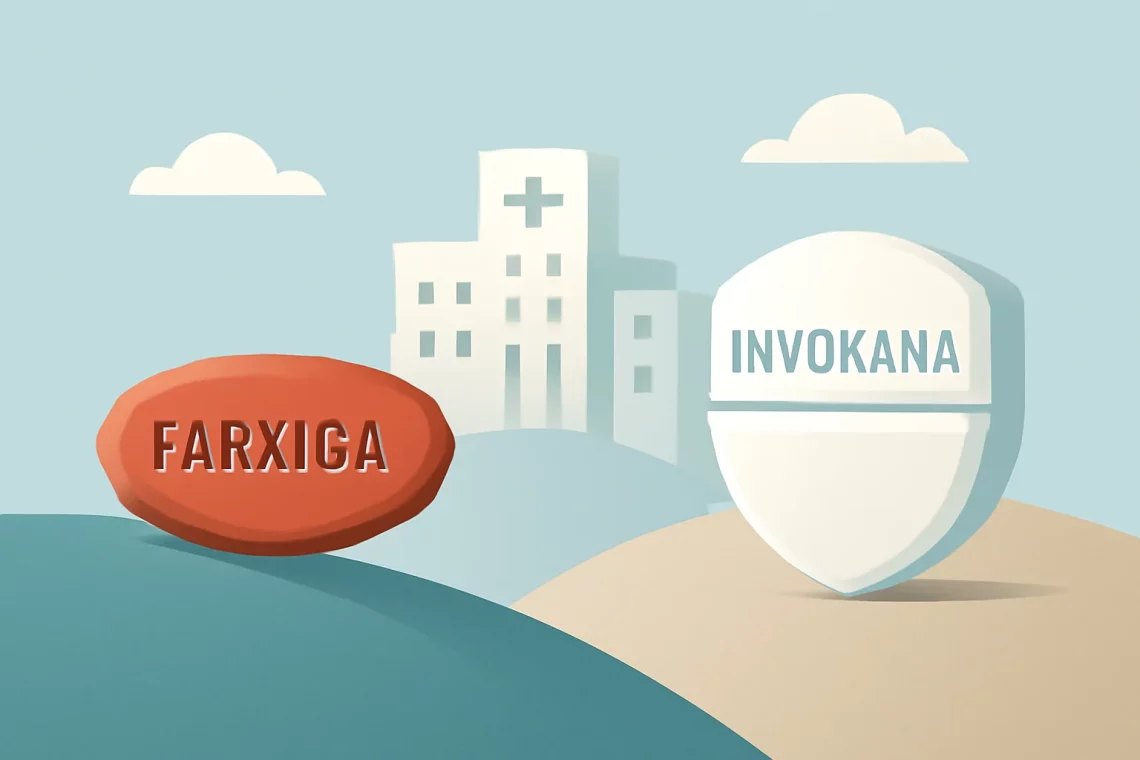
Farxiga vs Invokana: Which Diabetes Medication Is Right for You?
The landscape of diabetes management has evolved significantly over the years, with a variety of medications available to help individuals control their blood sugar levels. Among these treatments, two prominent options are Farxiga and Invokana. Both medications belong to a class of drugs known as SGLT2 inhibitors, which work by preventing the reabsorption of glucose in the kidneys, thereby allowing excess sugar to be excreted through urine. This mechanism not only aids in blood sugar control but also offers additional benefits, such as weight loss and improved cardiovascular health.
As the prevalence of type 2 diabetes continues to rise globally, the choice of medication becomes crucial in managing the condition effectively. Patients often face the dilemma of selecting the most suitable treatment for their needs. Farxiga and Invokana have garnered attention for their unique properties and potential side effects. Understanding the similarities and differences between these two medications is essential for making an informed decision about diabetes management.
In this article, we will delve deeper into the characteristics, benefits, and considerations surrounding Farxiga and Invokana, enabling readers to gain a comprehensive understanding of these medications and their roles in diabetes care.
Understanding Farxiga: Mechanism and Benefits
Farxiga, generically known as dapagliflozin, is an SGLT2 inhibitor that has been widely prescribed for the management of type 2 diabetes. Its primary function is to block the sodium-glucose cotransporter 2 (SGLT2) in the kidneys, which plays a significant role in glucose reabsorption. By inhibiting this transporter, Farxiga promotes the excretion of excess glucose through urine, effectively lowering blood sugar levels.
One of the key benefits of Farxiga is its dual action on blood sugar control and cardiovascular health. Clinical studies have highlighted that patients using Farxiga not only experience improved glycemic control but also a reduced risk of heart failure and other cardiovascular events. This makes it a compelling choice for individuals with diabetes who may also be at risk for heart-related complications.
Additionally, Farxiga has been associated with weight loss, which is a significant advantage for many patients struggling with obesity alongside diabetes. As the medication helps eliminate excess glucose, it also reduces calorie intake, contributing to an overall decrease in body weight. This benefit can enhance a patient’s self-esteem and motivation in managing their diabetes effectively.
However, like any medication, Farxiga is not without its potential side effects. Common adverse reactions can include urinary tract infections and genital mycotic infections, primarily due to the increased glucose in the urine creating an environment conducive to bacterial growth. Patients should be aware of these risks and consult with their healthcare provider to weigh the benefits against potential complications.
Overall, Farxiga presents a multifaceted approach to diabetes management, combining glycemic control with cardiovascular benefits and weight loss. Its unique mechanism of action and positive outcomes make it a valuable option for many individuals living with type 2 diabetes.
Exploring Invokana: Mechanism and Advantages
Invokana, known generically as canagliflozin, is another prominent SGLT2 inhibitor used in the treatment of type 2 diabetes. Similar to Farxiga, Invokana functions by inhibiting the SGLT2 protein in the kidneys, resulting in increased glucose excretion and lower blood sugar levels. This mechanism not only aids in glycemic control but also offers additional health benefits.
One of the standout features of Invokana is its potential to provide renal protection. Studies have suggested that Invokana may help reduce the risk of kidney disease progression in patients with type 2 diabetes, which is a crucial consideration given the increased risk of renal complications in this population. By preserving kidney function, Invokana can contribute to the overall health and quality of life for individuals managing diabetes.
Invokana also shares the weight loss benefit associated with other medications in its class. By promoting glucose excretion, patients may experience a reduction in caloric intake, leading to gradual weight loss. This can be particularly advantageous for individuals who are overweight or obese, as losing even a small percentage of body weight can significantly improve diabetes management.
However, it is important to note that Invokana has its own set of potential side effects. Patients may experience issues such as dehydration, low blood pressure, and an increased risk of lower limb amputations in certain populations. Therefore, it is vital for patients to have thorough discussions with their healthcare providers about the risks and benefits of using Invokana.
In summary, Invokana offers a robust option for managing type 2 diabetes, with its dual benefits of glycemic control and kidney protection. Understanding its unique attributes can help patients make informed decisions regarding their diabetes treatment plans.
Comparative Effectiveness: Farxiga vs. Invokana
When evaluating Farxiga and Invokana, it is essential to consider their comparative effectiveness in managing type 2 diabetes. Both medications have demonstrated significant improvements in glycemic control, but individual responses can vary based on factors such as patient health status, lifestyle, and potential comorbidities.
Clinical trials have shown that both Farxiga and Invokana effectively lower HbA1c levels, a key indicator of long-term blood sugar control. However, some studies suggest that Farxiga may have a slightly more favorable impact on cardiovascular outcomes compared to Invokana. This aspect is significant for patients with a history of heart disease or those at high risk for cardiovascular events.
Weight loss is another area where both medications shine, but again, individual results may differ. Some patients may find that one medication leads to more noticeable weight loss than the other, emphasizing the importance of personalized treatment plans.
When considering side effects, patients may have different experiences with each medication. While both have similar risks, the specific adverse reactions may vary from person to person. Therefore, it is crucial for individuals to monitor their health closely when starting a new medication and to communicate any concerns with their healthcare provider.
Ultimately, the choice between Farxiga and Invokana should be made collaboratively between the patient and their healthcare professional. By discussing individual health goals, preferences, and potential risks, patients can choose the medication that best aligns with their diabetes management plan.
Conclusion: Making an Informed Choice
In conclusion, both Farxiga and Invokana represent vital options for individuals managing type 2 diabetes. Their mechanisms of action as SGLT2 inhibitors provide effective glycemic control while also offering additional benefits such as weight loss and cardiovascular protection. However, the choice between these two medications should not be taken lightly, as individual responses and potential side effects vary widely.
Before starting any new medication, it is important to consult with a healthcare provider to discuss personal health needs, potential risks, and the overall treatment strategy. Each patient’s journey with diabetes is unique, and a tailored approach is essential for optimal management.
As with any medical treatment, this article is for informational purposes only and should not be considered medical advice. Always consult with a healthcare professional regarding any health concerns or before making changes to your treatment plan.




